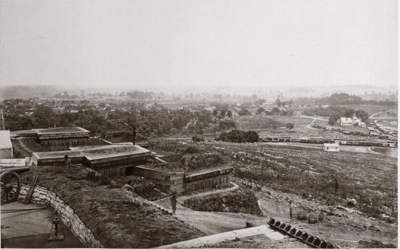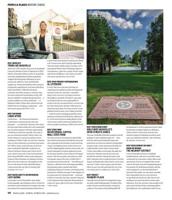In July, I asked why the Heritage Protection Act didn’t apply to Fort Negley Park, when it seemed so obvious that it must. Now the Friends of Fort Negley seem poised to have the courts weigh in on just that fact.
Joey Garrison over at The Tennessean has the story:
Friends of Fort Negley, the plaintiff in a petition filed on Monday, asks the Tennessee Historical Commission to issue an order finding that the entire acreage of the Fort Negley site, including the Greer Stadium site, is a "historical memorial" under state law.Historic memorials, under the Tennessee Historic Preservation Act of 2016, cannot be disturbed or altered unless the public entity that controls the memorial is granted a special waiver from the Tennessee Historical Commission.
Garrison also mentions that “[Cloud Hill developer Bert] Mathews and the mayor's office have argued that the Greer Stadium property is separate from the Fort Negley Park, but preservationists have argued that it is part of the historic site.”
Here’s some of the backstory on that part. According to emails made available to Pith after my July post ran, Mike Jameson contacted Jon Cooper, the city's attorney, saying that a council member had asked for an opinion about whether the Tennessee Heritage Protection Act applied to the Fort Negley/Greer Stadium development.
Cooper sent Jameson back a long explanation for why the city thought the act didn’t apply. In part, it read:
If the plan was to redevelop Fort Negley, the Act would likely apply. However, we confirmed with Purchasing that the RFP was limited to the development of the Greer Stadium site. While the entire area has been referred to as Fort Negley Park, the Greer Stadium site is a separate parcel from that of Fort Negley. The Greer Stadium property is located at 534 Chestnut Street (Map/Parcel No. 10502043400) and was acquired from MDHA in the 1970s as part of an urban renewal project. The property is zoned IWD, which permits stadiums as a use by right. This property has been used for more than 40 years either as Little League ball fields or a minor league baseball facility. On the other hand, Fort Negley has a separate address and map/parcel number and was acquired by Metro in 1967. It is zoned MUL, which doesn’t permit a stadium.
The city has hung a lot of its hopes on this paragraph being true. But is it?
According to an article in The Tennessean dated Oct. 14, 1928, “Fifty acres surrounding old Fort Negley, now known as St. Cloud Hill, were bought by the Nashville Park commission.” The Tennessean then goes on to describe the boundaries of the purchase: “It is bounded in the west by Cumberland avenue or Ridley avenue, on the South by Chestnut street, on the east by the L. and N. railway and on the north by an alley.” Some of those landmarks are gone now, but it’s clear that the Greer Stadium section of the park was included as a part of the park from the get-go.
Throughout the years, you can read story after story of kids playing ball at Fort Negley Park, clearly on the land that is now Greer Stadium. In fact, before Greer Stadium was named, the paper referred to it as the stadium at Fort Negley Park or the Fort Negley Park stadium.
So what about these two parcels and the weird Metro Development and Housing Agency deed? There are two places easily available to the public to look at parcel information — the property assessor’s site and Metro Metro Planning’s parcel viewer. Both of these sites give the same information about Parcel No. 10502043400 (the Greer Stadium part of the Park.) The earliest record available online shows the city recording ownership of that parcel in 1954 in a warranty deed. That parcel was not acquired by Metro in 1967, but was held by the city from at least 1954 — and obviously, since they bought the park in 1928, since 1928. There’s no MDHA deed on this parcel.
But there is an MDHA deed associated with the other parcel. And that deed is very interesting. Well, I mean, if you’re a history nerd like me. So to be clear, we’re now talking about Parcel No. 10502044600, which is everything in the park — the fort, the Adventure Science Center and the far north gravel parking lot beyond Greer — that is not the stadium and the paved parking lots immediately surrounding it.
So the deed records a sale of land, land that is now in this parcel, to the city from MDHA. If you’ve been following my writing about Fort Negley Park, you may have already correctly guessed what could be inside the park’s boundaries, but not clearly in the park from the get-go.
The property starts at an iron pin “in the northerly margin of Hume Street in the easterly line of Nashville’s Fort Negley Property” and runs north to an alley, east to the L&N Railroad property, south to Hume Street, and back to the beginning. Problem: There’s no Hume Street anymore.
But if you look at this Tennessee State Library and Archives (unofficial motto: “Find All Lost Roads Inside”) map, there’s Chestnut, under its old name “Franklin Street,” and north of it is Hume. And look what’s north of Hume — the old Catholic cemetery.
Now it makes sense. The Catholic Cemetery relocated when the railroad wanted to fix that curve. The Catholic church didn’t want half a cemetery there and half a cemetery somewhere else, so out goes the Catholic Cemetery, but the railroad wouldn’t have needed all that land. I haven’t been able to trace the whole history of that land, but we shouldn’t be surprised to find that that portion of the park wasn’t officially integrated into the park until the 1970s.
The important thing is that the MDHA deed isn’t for the stadium property. It’s for the old Catholic Cemetery property — the far north gravel parking lot.
The funny thing is that the city has been relying on the argument that there are two separate parcels and one is straightforwardly the park and the other has had a convoluted ownership, and in fact, that appears to be true. But the part of the park clearly owned by the city as a park all these years is the Greer Stadium parcel, not the fort parcel.
I still remain somewhat pessimistic about the park being saved. But I’ll be curious to see what the courts make of the city’s claims and the new law designed to protect our old places.





